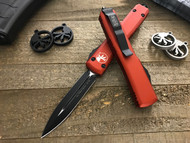Choosing the Best Knife Steels: A Starting Guide
Jun 18th 2024
Choosing the Best Knife Steels
In the world of knives, the steel used in their blades is crucial. It determines not only their performance but also their durability and maintenance needs. Whether you're an avid outdoorsman, a professional chef, or a knife enthusiast, understanding the nuances of knife steels can significantly impact your choice of blade. From edge retention to corrosion resistance, each steel type brings its own strengths and characteristics to the table. In this guide, we delve into some of the best knife steels available today, highlighting their features, applications, and what sets them apart.
Understanding Knife Steel Basics
Before diving into specific types of knife steels, it's essential to grasp some fundamental concepts:
- Composition: Knife steels are alloys composed primarily of iron, carbon, and other elements such as chromium, vanadium, and molybdenum. The proportions of these elements influence the steel's properties.
- Hardness: Measured on the Rockwell Hardness Scale (HRC), hardness affects edge retention and ease of sharpening. Higher HRC values indicate harder steels that can hold an edge longer but may be more brittle.
- Edge Retention vs. Toughness: There's often a trade-off between edge retention (how long the blade stays sharp) and toughness (the ability to withstand impact and stress without chipping or breaking).
- Corrosion Resistance: Some steels are more resistant to rust and corrosion than others, making them suitable for environments with high moisture or salt exposure.
Top Knife Steels and Their Applications
1. VG-10 Steel
VG-10 steel is a high-carbon stainless steel primarily used in premium kitchen knives and high-end folding knives. It's known for:
- Edge Retention: Excellent edge retention, making it ideal for kitchen tasks that require prolonged sharpness.
- Corrosion Resistance: Good resistance to corrosion, thanks to its chromium content.
- Ease of Sharpening: Relatively easy to sharpen compared to other stainless steels of similar hardness.
2. S30V Steel
Popular in the realm of tactical and everyday carry knives, S30V steel offers:
- Edge Retention: Exceptional edge retention due to its high vanadium and carbon content.
- Toughness: Good toughness compared to other stainless steels in its class.
- Corrosion Resistance: Decent corrosion resistance, though not as high as some stainless steels.
3. D2 Steel
D2 steel is a semi-stainless tool steel known for:
- Edge Retention: Very good edge retention, suitable for heavy-duty use and woodworking tools.
- Toughness: High toughness, able to withstand abuse without chipping easily.
- Corrosion Resistance: Moderate corrosion resistance; requires proper maintenance to prevent rust.
4. M390 Steel
M390 steel is a powder metallurgy stainless steel prized for:
- Edge Retention: Outstanding edge retention, among the best available in stainless steels.
- Corrosion Resistance: Excellent corrosion resistance, making it suitable for marine and outdoor applications.
- Toughness: Good toughness for a stainless steel, though not as tough as non-stainless options like D2.
Factors Influencing Steel Selection
Choosing the right knife steel involves considering several factors:
- Intended Use: Different steels excel in specific applications, such as kitchen knives, outdoor knives, or everyday carry knives.
- Maintenance: Some steels require more attention to prevent rust and maintain performance.
- Budget: Higher-performance steels often come at a premium price, so balancing performance with cost is essential.
Conclusion
The world of knife steels is vast and ever-evolving, with new alloys and technologies continually pushing the boundaries of performance. Whether you prioritize edge retention, corrosion resistance, or toughness, there's a steel out there to meet your needs. By understanding the characteristics of different knife steels and how they align with your usage patterns, you can make an informed decision when selecting your next blade.
In conclusion, while no single steel is perfect for every situation, the best knife steel is ultimately the one that best matches your specific requirements and preferences. Whether you're preparing a gourmet meal, trekking through the wilderness, or simply opening packages at home, a well-chosen blade can enhance your experience and make tasks easier and more enjoyable. So, take the time to explore the options, experiment with different steels, and discover the perfect blade that suits your unique style and needs. Happy cutting!

